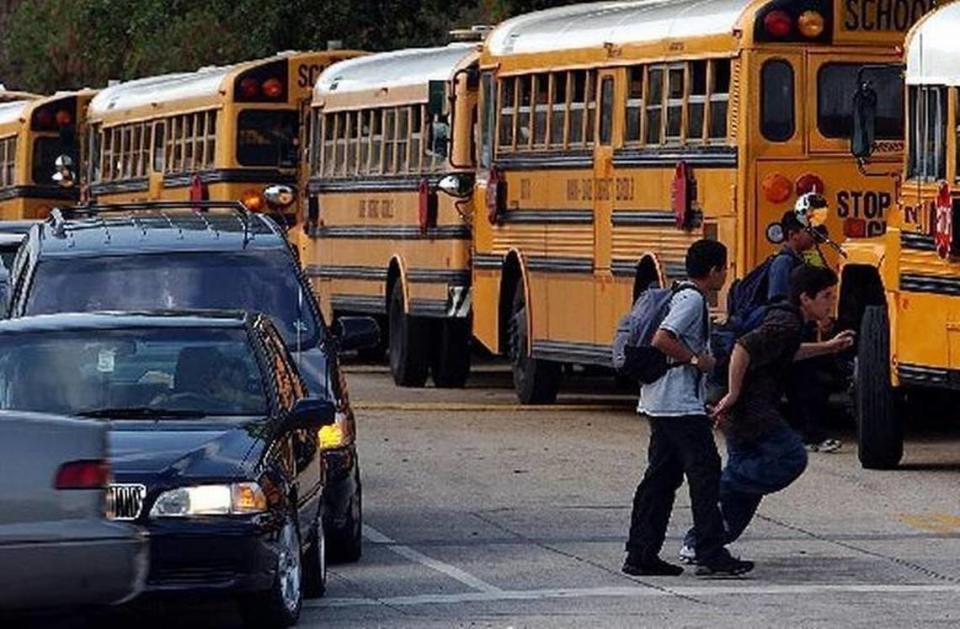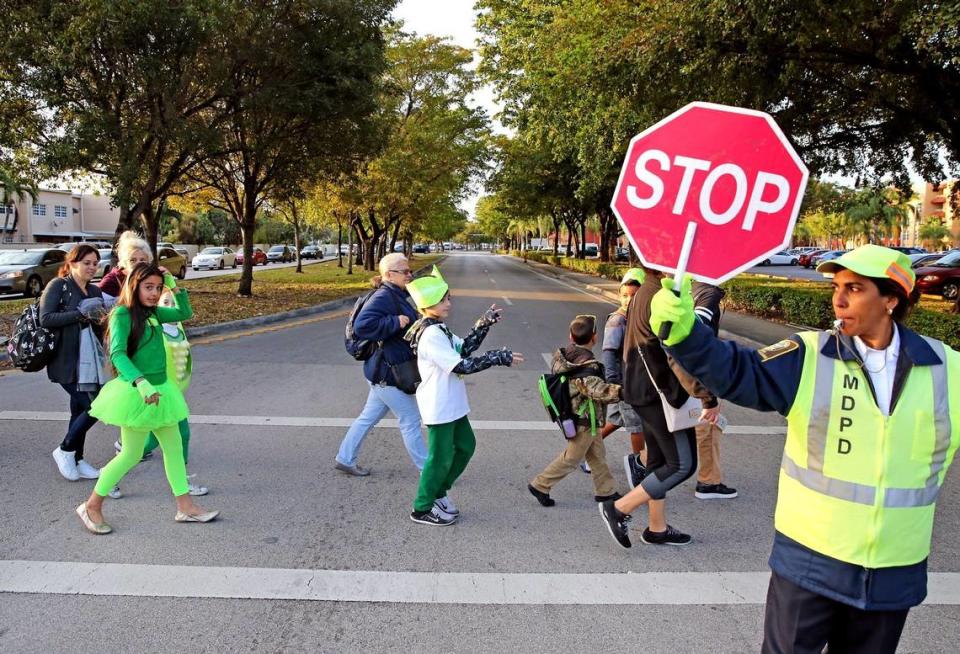It’s back to school for Miami kids. This is what drivers need to know to avoid problems
“I don’t think I’m mentally prepared for that back to school traffic.”
This Twitter user echoed the thought going through thousands of drivers’ heads who may be stuck in gridlock on Monday morning and afternoon in Miami-Dade.
Not just your usual gridlock. But that first day, Back to School in Miami-Dade Blues.
And it’s a scenario that will play out almost every weekday until the time schools let out for summer recess in 2020.
Broward County and Keys schools opened last Wednesday.
i don't think i'm mentally prepared for that back to school traffic
— ⎊ (@loversstark) August 16, 2019
Can we ever be “mentally prepared” for the tie-ups brought on by more cars on the roads, 15 mph morning and afternoon school speed zones, big yellow school buses we must stop for, and the constant roadway construction? Even without the extra school traffic on the streets, roadwork seems 24/7 and year-round here.
But here’s one thing to know: Miami-Dade County Public Schools will transport more than 40,000 students — twice daily — this school year, according to the district. The students will ride on a fleet of 1,060 buses along more than 880 school-bus routes.
That’s not counting all the moms and dads and friends who will be driving their kids — solo and in car pools — and the kids who will huff it out on foot or bike to nearby schools.
There are about 345,000 students and 40,000 employees spread among 392 public schools in Miami-Dade — the nation’s fourth largest school district. And remember that commuting teachers are hitting the road twice a day, too, now that summer break is over.
School year road rules
If you’re new to the Miami-Dade area and haven’t been through the drill, here’s some of what you need to know to successfully follow traffic laws during the school year. Just remember: These rules are designed to keep your kids safe.
Avoiding some of the busiest times or the most clogged roads may even help you to maintain your sanity on streets that are under construction and will near completion when your kindergartner enters middle school.
Happy Friday Panther Nation!! Thank you LH community for your support & patience with the back to school traffic. We know to keep our students & community safe is everyone's first priority, please keep these tips in mind while driving during school times. #transportingchampions pic.twitter.com/RKYNrhtuxN
— LHISD Communications (@lhisdcomms) August 16, 2019
Here are three things to remember:
1. “Stop, Drop & Roll with a Twist.” That’s Miami-Dade Fire Rescue’s Back to School initiative this year in regard to school bus safety. Catchy phrase aside, it’s the law to stop for school buses. And this applies not only when you are in the same lane behind the stopped yellow bus but also if you are in immediate lanes that travel adjacent in the other direction.
According to the National Safety Council, 26 students were killed and 9,000 were injured in incidents involving school buses during the 2018-19 school year nationwide.
“More often than not, these deaths and injuries occurred as children were entering and exiting the bus,” the council said.
That’s why you stop for a school bus when it slides out its red stop sign flap.
According to Daisy Gonzalez-Diego, spokeswoman for Miami-Dade County Public Schools, the district’s 1,060 buses will undertake “the massive operation” of transporting about 45,000 school children twice daily via 883 routes in the county. The bus drivers will travel more than 13 million miles this school year, covering 2,400 square miles throughout Miami-Dade.

So the fire rescue’s “Stop, Drop & Roll with a Twist” campaign emphasizes these safe-driving behaviors:
▪ STOP accelerating.
▪ DROP your speed to 15 mph.
▪ ROLL carefully through the school zone.
What’s the “Twist” part? Not sure. Maybe it’s the old Chubby Checker song that was No. 1 on the nation’s pop charts in 1960 at the time you started out on your commute Monday morning to get to work.
For this first day of school, Miami-Dade Fire Rescue plans to have in-service units positioned at various elementary schools throughout the county from 7:30 a.m. to 8:15 a.m. Monday to highlight school-zone safety.
Fire Rescue has compiled a list of safety tips that covers driving in cars and buses but also biking and walking to school and how to keep your children safe when they get home from school. The list is at: https://www8.miamidade.gov/global/fire/safety-back-to-school.page.
Gonzalez-Diego noted that parents can inquire about their children’s bus routes. Transportation center contact numbers are listed at: www.pupiltrans.org/terminals.html.
2. Heed speed limits at school zones. We know it’s excruciating to crawl along at 15 mph for blocks. And blocks. And sometimes more blocks on top of that when you get to neighborhoods with more than one school in the area. Drivers should have extra patience if they are taking Ives Dairy Road in the north part of the county and Miller Drive in the south, for example. The Ives Dairy corridor between U.S. 1 and just west of I-95 has at least five schools — and lots of backups even when they’re not in session.
The 15 mph zone is law in Miami-Dade County. Expect the speed limit to be enforced 30 minutes before and after a school’s posted times of operation. You will see flashing yellow lights to alert you that you are in a school zone.
Speaking of which ...
3. Note the time. It’s on the sign. “School hours depend on the grade. Elementary, middle, K-8, high schools have different start and end times. Some schools have extended language programs, so those end an hour later,” Gonzalez-Diego said.
In general, though, middle school hours are 9:10 a.m. to 3:50 p.m. Senior high school hours are 7:20 a.m. to 2:20 p.m. Elementary schools generally run 8:30 a.m. to 3 p.m. Some elementary, middle and senior high schools, as well as some special K-8 and alternative-education centers, will operate on individual schedules, according to the school system.

Road closures, headaches
Now that you are prepared, which roadways should you avoid?
Some of the worst: the Palmetto Expressway, Interstate 95, and the Airport Expressway. But you can’t just stay in bed with your head under the pillow.
A good rule of thumb is to leave 30 minutes to an hour earlier than usual to get to your destination. This is a good time to catch up on the “Moby Dick” audiobook you’ve been meaning to conquer. Captain Ahab would have had an aggravating time navigating South Florida’s increasingly confusing roadways.
You might not have to take the three highways that feed downtown Miami, Miami Beach and the Civic Center to get to school. But the redesign of I-395 to put a bridge over Biscayne Boulevard is already forcing drivers to seek alternate routes on surface roads that intersect with schools and daycare centers.
This means more traffic jams for school-bound families, high school juniors and seniors who just got their driver’s licenses, and for those who haven’t any children in school but are a part of the daily traffic mix.
Then there’s that new lane closure that stretches for at least a mile northbound immediately after the Bird Road entrance to Florida’s Turnpike. That roadway-expanding project has bottlenecked that portion of a turnpike whose peaceful easy slogan, “The Less Stressway,” lately seems a mockery. A stretch of the turnpike near Hard Rock Stadium also is seeing slow-ups from construction.
The sight of cars backed up for miles on the turnpike on weekdays that crawl past speed limit signs touting 60 or 70 mph speed limits has led drivers to spill onto adjacent surface roads, like Southwest 117th Avenue near Florida International University in West Miami-Dade. But that road — which feeds Kendall Drive, Sunset Drive, Miller Drive and Bird Road — is torn up for not one but two projects.
There’s years-long redesign work on 117th in front of homes not far from Cypress Elementary School, Westwood Park, Kendall Regional Medical Center and Smart Kids Children’s Learning Center.
Add to the obstacles: a Miami-Dade Water and Sewer replacement project on 117th that began in August 2018.
That $37.2 million work on underground pipes on Southwest 117th heading south is along a busy road that takes in businesses, a Kendall police station and fire department and The Palms at Town and Country Mall.
That public works project, and its detours, was originally supposed to end in November 2019. Now, it is not expected to be completed until April 2020, according to a spokesman for the project.

Angry residents
Meanwhile, a group of residents in Miami Lakes and Hialeah are so angry over the closing of lanes on the Palmetto Expressway to refashion them as toll express lanes that they posted a “We, the People, Have Had Enough!” letter on a LinkedIn page on Saturday addressed to Florida Sen. Rick Scott. They demand the removal of these express lanes.
“Right before the school year starts, Palmetto X-Way’s removal of lanes that are vital to our ability to flow out of our communities… [is] angering communities on both sides of I-75,” the group sent in an email to the Miami Herald.
The Palmetto express lanes are open in Miami - and the traffic is hot garbage
The Miami Lakes group also wants two bridges in Hialeah at 154th and 170th streets opened to ease traffic congestion in the surrounding neighborhood.
Whatever delay you face on your commute Monday and beyond, just remember: School is back in session, and kids on the street need to stay safe.
